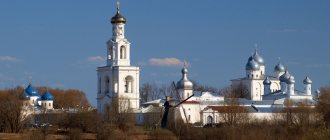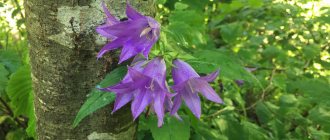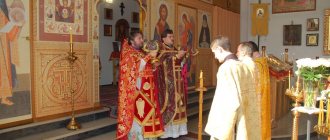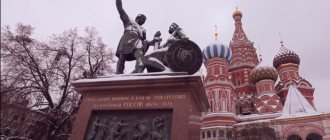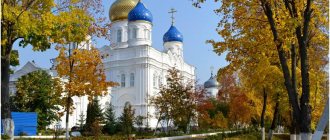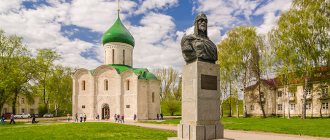Olga GENINA and Dmitry POLUKHIN.
We publish the addresses of healing places in the Moscow region and the regions closest to the capital.
Hot summer is the most fertile time to plunge into the invigorating spring water that washes away the blues. It is most convenient to do this in fonts specially equipped for ablution, which are found in many monasteries near Moscow. Both soul and body will benefit from such a bath.
Knowledgeable people advise avoiding heavy libations on the eve of a trip and not overeating. And most importantly, do not forget that the font is not an ordinary river, but a holy place. It is advisable to support yourself with prayer while bathing. If you don’t have the courage to dive in one fell swoop, you can wash your face, hands or feet, and drink healing water right on the spot.
Source "Gremyachiy" in Malinniki
Popular rumor says that this is one of the most miraculous sources. It is located 14 km from Sergiev Posad, near the village of Vzglyadnevo, on the left bank of the Vondiga River. A spring appeared about 600 years ago at the place where St. Sergius of Radonezh stopped to rest. The saint prayed earnestly for the unification of the Russian people and liberation from the Mongol-Tatar yoke, and suddenly a pure spring came from the mountain. It is also interesting that the water of the source is slightly mineralized and is close in composition to the Kislovodsk Narzan, so experts advise drinking it in limited quantities as a medicinal source.
Each of the streams of this key is credited with different healing properties: the right one – “from the heart”, the middle one – “from the head”, the left one – “from female diseases”. To approach the source, you need to climb a wooden staircase with several rest areas. The bathhouse, consisting of an open pond under a roof and a closed room, is located to the right of it. You can take water procedures in the font, or you can stand under the falling stream. They say the water temperature there is +4 degrees all year round. Experienced pilgrims advise coming on weekdays, because there are too many people on weekends.
How to get there
By car
From Yaroslavskoye Highway, turn onto the Small Concrete Ring (MBK) to the right towards the M7 highway. After 7 km there will be a large holiday village called Voronino. From there, 3 km until you turn right onto a dirt road to the source. There is no pointer there. From the MBK turn, drive 500 meters down to the bridge over the Karpovka River. Then 1.3 km to the lowland of the Karpovka River with a tributary stream along a dirt road and 1.2 km to the fork in the roads to the villages of Vzglyadnevo (left) and Voronino (right). From the fork, turn 700 meters to the right to the village of Vzglyadnevo along a dirt road that rises onto a field and goes around the village.
On your own
By train from Yaroslavsky station to Sergiev Posad station. At the station there will be bus number 120 to the village of Voronino (there is a store at the stop). Then 30 meters forward and turn right onto the country road. Walk past a long row of houses, past the Karpovka River and climb to the village of Voronino (1.5 km). From here, take a difficult-to-pass dirt road 1 km to the fork.
Address, website, coordinates
- Address: Vzglyadnevo, Sergiev Posad district, Moscow region, Russia.
- GPS coordinates: 56.270332, 38.343908.
- Official website: https://gremyachiy.rf
- VKontakte page: https://vk.com/gremyachiy_kluch
One of the main holy places of the city of Sergiev Posad is Gremyachiy Klyuch - a source waterfall, notable for its fresh, tasty water and incredibly picturesque landscape. The space around it is perfectly organized: the infrastructure does not detract from the value of these places, but, on the contrary, allows you to spend time here as richly and comfortably as possible. In conclusion, a video tour of it, enjoy watching!
Savvino-Storozhevsky Monastery
It is located 50 kilometers from Moscow, on the left bank of both the Moscow River and the Razvarnya River. Founded in 1398 by the Monk Savva of Storozhevsky, a student of Sergius of Radonezh. This monastery has always enjoyed the favor of Russian sovereigns. Here, on the outskirts of Zvenigorod, Tsar Ivan IV the Terrible and his wife Anastasia Romanovna came to venerate the relics of the Monk Sava, and later their son Feodor Ioannovich.
Today's pilgrims can purchase delicious home-made bread and kvass at the monastery. About 700 meters from the monastery are the monastery and spring of St. Sava. A magnificent wooden chapel has recently been erected over the spring. You can swim there in summer and winter. The chapel has two large fonts: men's and women's, with spacious dressing rooms.
How to get there
By car
It is better to drive along the Novorizhskoe highway to Zvenigorod. Then go to the sign “Savvino-Storozhevsky Monastery”.
On your own
From Belorussky railway station to Zvenigorod station. From there, take bus No. 23 or 51 to the “D/O Ministry of Defense” stop. To get to the monastery, you need to leave the monastery, turn left and walk along a narrow asphalt road down the edge of a deep ravine.
The Legend of Gremyachey Key
There is an interesting legend about how the source appeared. The legend tells of Sergius of Radonezh and Roman of Kirzhach, a disciple of the elder, who left their native monastery due to discord among their brothers.
The travelers followed the Kirzhach River and walked many kilometers before stopping to rest. It was summer time, so it was easy to find food - unlike drinking water. Roman could no longer tolerate thirst and asked the monk to pray to God to create a source of cool water for them.
The elder saw the suffering of his disciple and, in gratitude for his faith and obedience, said a fervent prayer, hit the steep slope with his staff and immediately hammered a spring from there. Having drunk enough, the wanderers moved on, and the source continued to flow along the hill: for 7 centuries its holy waters have been helping believers.
David's Hermitage - Talezh
The Voznesenskaya Davidova Hermitage is located 80 km south of Moscow, near the city of Chekhov. The monastery stands on the banks of the Lopasni River, which flows into the Oka, on a high white-stone mountain. The monastery was founded on May 15, 1515 by the Monk David from the family of princes of Vyazemsky. Not far from the monastery, in the village of Talezh, there is a desert courtyard. There, from under the ground comes an abundant spring, consecrated in the name of the Monk David. A whole spring complex was built next to it: the temple of St. David, a belfry and two indoor baths - men's and women's. They say that healing from eye and liver diseases occurs at the spring.
How to get there
By car
Drive along the Simferopol highway, take the second turn towards Chekhov. At the sign for Kryukovo, turn off the highway and go straight all the way to the village of Novy Byt. To get to Talezh, you need to return to the Simferopol highway, cross it and continue straight towards Melikhovo. After about 10 km there will be a sign “Talezh. Source in the name of St. David”, where you need to turn left and get to the next sign “Holy Source”.
On your own
By train from Kursky station to Chekhov station, then by bus number 25 to the turn to Talezh, from there on foot 1.5 km.
Holy Kazan Convent
Located in the Tula region, in which there are 27 holy springs. The most revered of them is in the Holy Kazan Convent. It was founded according to the prophecy of the blessed elder Euphrosyne, in the world of Princess Vyazemskaya. She was from a noble family, received her education at the Smolny Institute and became a favorite maid of honor at the court of Catherine the Great. At some point, with two other ladies-in-waiting, she left Tsarskoe Selo and wandered around the monasteries until she found a spring near the village of Kolyupanovo, the water from which, according to legend, has life-giving powers.
The water from this spring is believed to cure all diseases and illnesses, especially cancer and blindness. Water flows from three pipes. There are two baths - women's and men's. Above the source there is a large cross, under it there is an inscription: “Take water from my well and you will be healthy.”
How to get there
By car
Drive along the Simferopol highway and at the 114th kilometer turn following the sign for the city of Aleksin. Under no circumstances should you turn into Aleksin at the first sign - the bridge there is closed. You need to drive further along the highway, and after 10 kilometers there will be a turn in the Yasnogorsk area. When you reach Aleksin, ask where the source is.
On your own
From Kursky station get to Tula. Next, take the Uzlovaya – Aleksin train from Ryazhsky station to Kolyupanovo station. Then walk about two kilometers along the path through the forest following the sign.
To dip or not
Neither experts nor experienced walruses recommend diving into an ice hole without special training. You need to harden yourself ahead of time - at least two to three months in advance, start with a contrast shower. Before swimming, you need to do a little warm-up and warm up. It is better to protect your head not only with a rubber cap, but also with a woolen one - put it down.
Those who suffer from diseases of the cardiovascular system, especially those who have suffered a heart attack or stroke, will have to avoid plunging into ice water, TASS reminded. People with chronic illnesses are also advised to refrain from swimming.
Photo source: RIA Novosti
But at the Gamaleya Research Center for Epidemiology and Epidemiology, those vaccinated against coronavirus were allowed to dive into the ice hole. Vaccination itself does not interfere with the custom.
“Vaccination can in no way be connected with bathing,” said the director of the Center, Alexander Gintsburg.
He noticed that a seasoned person who has plunged into an ice hole not for the first time can be confident in his body.
“If a person is not trained and is predisposed to hypertension, then it is better for him not to do this so that he does not have a stroke or heart attack. And this has nothing to do with vaccination,” concluded Ginzburg.
Optina Pustyn – Shamordino
The desert is located on the banks of the fast river Zhizdra, cutting it off from the rest of the world, and is surrounded by forest. The Holy Vvedensky Monastery is one of the oldest in Russia. According to local legend, the monastery was founded by the ataman of a gang of robbers, nicknamed Opta, who repented and took monastic vows with the name Macarius. L.N. Tolstoy, F.M. Dostoevsky, N.V. Gogol visited here. Near the monastery on the bank of the Zhizdra River there is a spring of St. Paphnutius with a font. It's easy to find. You need to leave the monastery gate, turn right and walk along the forest along a country road to a metal barrier. Then go out onto the path that this barrier blocks and walk along the river bed. After 350 meters there will be a fenced spring.
How to get there
By car
Drive along the Kievskoye Highway, passing the turn to Kaluga. At the 186th kilometer of the highway you need to cross a road bridge, after which there will be a sign for Optina. Next we head towards Kozelsk - straight ahead all the time and near the monument following the sign to the right. There, go to the traffic light and turn left. After the bridge over the river, take the first left (there is a sign there). The road from the highway to Kozelsk is for the most part not bad, but you can also drive through Kaluga, especially on the way back; signs for Moscow lead through Kaluga.
On your own
A bus leaves daily from the Yugo-Zapadnaya metro station on the route Moscow - Kozelsk. From the bus station in Kozelsk to the monastery it is about three kilometers.
LiveInternetLiveInternet
Summer is the most fertile time to plunge into the invigorating spring water that washes away the mental blues. It is most convenient to do this in fonts specially equipped for ablution, which are found in many monasteries near Moscow. Both soul and body will benefit from such bathing. Source "Gremyachiy" in Malinniki
Popular rumor says that this is one of the most miraculous sources. It is located 14 km from Sergiev Posad, near the village of Vzglyadnevo, on the left bank of the Vondiga River. A spring appeared about 600 years ago at the place where St. Sergius of Radonezh stopped to rest. The saint prayed earnestly for the unification of the Russian people and liberation from the Mongol-Tatar yoke, and suddenly a pure spring came from the mountain. It is also interesting that the water of the source is slightly mineralized and is close in composition to the Kislovodsk Narzan, so experts advise drinking it in limited quantities as a medicinal source.
Each of the streams of this key is credited with different healing properties: the right one – “from the heart”, the middle one – “from the head”, the left one – “from female diseases”. To approach the source, you need to climb a wooden staircase with several rest areas. The bathhouse, consisting of an open pond under a roof and a closed room, is located to the right of it. You can take water procedures in the font, or you can stand under the falling stream. They say the water temperature there is +4 degrees all year round. Experienced pilgrims advise coming on weekdays, because there are too many people on weekends.
HOW TO GET THERE
By car
From Yaroslavskoye Highway, turn onto the Small Concrete Ring (MBK) to the right towards the M7 highway. After 7 km there will be a large holiday village called Voronino. From there, 3 km until you turn right onto a dirt road to the source. There is no pointer there. From the MBK turn, drive 500 meters down to the bridge over the Karpovka River. Then 1.3 km to the lowland of the Karpovka River with a tributary stream along a dirt road and 1.2 km to the fork in the roads to the villages of Vzglyadnevo (left) and Voronino (right). From the fork, turn 700 meters to the right to the village of Vzglyadnevo along a dirt road that rises onto a field and goes around the village.
On your own
By train from Yaroslavsky station to Sergiev Posad station. At the station there will be a bus No. 120 to the village of Voronino (there is a store at the stop). Then 30 meters forward and turn right onto the country road. Walk past a long row of houses, past the Karpovka River and climb to the village of Voronino (1.5 km). From here, take a difficult-to-pass dirt road 1 km to the fork.
Savvino-Storozhevsky Monastery
It is located 50 kilometers from Moscow, on the left bank of both the Moscow River and the Razvarnya River. Founded in 1398 by the Monk Savva of Storozhevsky, a student of Sergius of Radonezh. This monastery has always enjoyed the favor of Russian sovereigns. Here, on the outskirts of Zvenigorod, Tsar Ivan IV the Terrible and his wife Anastasia Romanovna came to venerate the relics of the Monk Sava, and later their son Feodor Ioannovich. Today's pilgrims can purchase delicious home-made bread and kvass at the monastery. About 700 meters from the monastery are the monastery and spring of St. Sava. A magnificent wooden chapel has recently been erected over the spring. You can swim there in summer and winter. The chapel has two large fonts: men's and women's, with spacious dressing rooms.
HOW TO GET THERE
By car
It is better to drive along the Novorizhskoe highway to Zvenigorod. Then go to the sign “Savvino-Storozhevsky Monastery”.
On your own
From Belorussky railway station to Zvenigorod station. From there, take bus No. 23 or 51 to the “D/O Ministry of Defense” stop. To get to the monastery, you need to leave the monastery, turn left and walk along a narrow asphalt road down the edge of a deep ravine.
David's Hermitage - Talezh
The Voznesenskaya Davidova Hermitage is located 80 km south of Moscow, near the city of Chekhov. The monastery stands on the banks of the Lopasni River, which flows into the Oka, on a high white-stone mountain. The monastery was founded on May 15, 1515 by the Monk David from the family of princes of Vyazemsky. Not far from the monastery, in the village of Talezh, there is a desert courtyard. There, from under the ground comes an abundant spring, consecrated in the name of the Monk David. A whole spring complex was built next to it: the temple of St. David, a belfry and two indoor baths - men's and women's. They say that healing from eye and liver diseases occurs at the spring.
HOW TO GET THERE
By car
Drive along the Simferopol highway, take the second turn towards Chekhov. At the sign for Kryukovo, turn off the highway and go straight all the way to the village of Novy Byt.
To get to Talezh, you need to return to the Simferopol highway, cross it and continue straight towards Melikhovo. After about 10 km there will be a sign “Talezh. Source in the name of St. David”, where you need to turn left and get to the next sign “Holy Source”.
On your own
By train from Kursky station to Chekhov station, then by bus? 25 to the turn to Talezh, from there walk 1.5 km.
Holy Kazan Convent
Located in the Tula region, in which there are 27 holy springs. The most revered of them is in the Holy Kazan Convent. It was founded according to the prophecy of the blessed elder Euphrosyne, in the world of Princess Vyazemskaya. She was from a noble family, received her education at the Smolny Institute and became a favorite maid of honor at the court of Catherine the Great. At some point, with two other ladies-in-waiting, she left Tsarskoe Selo and wandered around the monasteries until she found a spring near the village of Kolyupanovo, the water from which, according to legend, has life-giving powers. The water from this spring is believed to cure all diseases and illnesses, especially cancer and blindness. Water flows from three pipes. There are two baths - women's and men's. Above the source is a large cross, below it is the inscription: “Take water from my well and you will be healthy.”
HOW TO GET THERE
By car
Drive along the Simferopol highway and at the 114th kilometer turn following the sign for the city of Aleksin. Under no circumstances should you turn into Aleksin at the first sign - the bridge there is closed. You need to drive further along the highway, and after 10 kilometers there will be a turn in the Yasnogorsk area. When you reach Aleksin, ask where the source is. On your own
From Kursky station get to Tula. Next, take the Uzlovaya – Aleksin train from Ryazhsky station to Kolyupanovo station. Then walk about two kilometers along the path through the forest following the sign.
Optina Pustyn – Shamordino
The desert is located on the banks of the fast river Zhizdra, cutting it off from the rest of the world, and is surrounded by forest. The Holy Vvedensky Monastery is one of the oldest in Russia. According to local legend, the monastery was founded by the ataman of a gang of robbers, nicknamed Opta, who repented and took monastic vows with the name Macarius. L.N. Tolstoy, F.M. Dostoevsky, N.V. Gogol visited here. Near the monastery on the bank of the Zhizdra River there is a spring of St. Paphnutius with a font. It's easy to find. You need to leave the monastery gate, turn right and walk along the forest along a country road to a metal barrier. Then go out onto the path that this barrier blocks and walk along the river bed. After 350 meters there will be a fenced spring.
HOW TO GET THERE
By car
Drive along the Kievskoye Highway, passing the turn to Kaluga. At the 186th kilometer of the highway you need to cross a road bridge, after which there will be a sign for Optina. Next we head towards Kozelsk - straight ahead all the time and near the monument following the sign to the right. There, go to the traffic light and turn left. After the bridge over the river, take the first left (there is a sign there). The road from the highway to Kozelsk is for the most part not bad, but you can also drive through Kaluga, especially on the way back; signs for Moscow lead through Kaluga.
On your own
A bus leaves daily from the Yugo-Zapadnaya metro station on the route Moscow - Kozelsk. From the bus station in Kozelsk to the monastery it is about three kilometers.
Holy springs of the Sheremetev estate (Chirkino village)
The estate in the village of Chirkino is the first ancient estate of the Sheremetev boyars. Near the village there are many pure, consecrated water sources. One of them is located in a lowland, directly under the temples of the village of Chirkino rising on the mountain. This is the source of “Joy to All Who Sorrow.” It is famous for its extraordinary concentration of silver. Its content in water exceeds the normal norm by twenty times! There is a bathhouse next to the spring.
Two other sources are located at the entrance to the temple complex, near the village of Shcherbinino, near the bridge over the river. The fourth source is especially famous - the ancient miraculous source of the prophet Elijah. It is mentioned in many historical descriptions, chronicles and church historiography of the Kolomna district of the 18th century.
HOW TO GET THERE
By car
Drive along Novoryazanskoye Highway. On the Small Concrete Ring (MBK) turn left following the signs “Myakinino” and “Temples, Springs”.
On your own
From the Vykhino metro station by bus? 402, 403 to Malin, then take bus No. 34 to the place.
@TVNZ
Holy springs of the Sheremetev estate (Chirkino village)
The estate in the village of Chirkino is the first ancient estate of the Sheremetev boyars. Near the village there are many pure, consecrated water sources. One of them is located in a lowland, directly under the temples of the village of Chirkino rising on the mountain. This is the source of “Joy to All Who Sorrow.” It is famous for its extraordinary concentration of silver. Its content in water exceeds the normal norm by twenty times! There is a bathhouse next to the spring.
Two other sources are located at the entrance to the temple complex, near the village of Shcherbinino, near the bridge over the river. The fourth source is especially famous - the ancient miraculous source of the prophet Elijah. It is mentioned in many historical descriptions, chronicles and church historiography of the Kolomna district of the 18th century.
Description of the waterfall
The waterfall near the village of Vzglyadnevo was known only to local residents for a long time, but in the middle of the 20th century, when mass tourism began to actively develop, it was included in the list of the most visited natural resources of the Moscow region. During the same period, its current name took place - Gremyachiy Klyuch. It was not chosen by chance: the sound of water falling from a steep hill could be heard far around.
The source is located in the middle part of the high right bank of the Vondiga River, surrounded by dense, deciduous forest and spacious fields. The stream flows from limestone crevices right in the center of the hill.
The height of the waterfall is about 13 m. It is considered one of the most famous and highest in the Moscow region.
Previously, the source flowed freely down the slope, but due to a sharp increase in the flow of tourists and pilgrims, it had to be improved: in the 20th century, wooden walkways were formed here. The path was shaky and in rainy weather it was almost completely flooded, making access to the waterfall very difficult. The transformation of Gremyachey Klyuch began in the 1990s: during that period, a comfortable staircase with a spacious upper platform was built, an icon case for several icons, and the streams of the source were enclosed in special gutters.
With the beginning of the new century, changes continued: the approach to the spring was again strengthened, fonts, water collection points, a church and souvenir shops, temples, a refectory and other important objects were built. For the convenience of visitors, all paths were designed as wooden paths with railings. The ensemble of the pilgrimage complex was not formed spontaneously: it was developed by architects A.N. Volkov and A.B. Barabanov. and Dyachkov K.K.
The main problem of the waterfall is transport accessibility. Finding the way to it is not difficult, but not everyone can overcome it: the pilgrimage complex is led by a simple dirt road with deep ruts, and often only well-passable vehicles can cope with it.
In wet weather, we recommend being especially careful: it’s very easy to get stuck here.
Travelers note that Gremyachiy Klyuch is beautiful all year round, and the surrounding area is carefully monitored - it is cleaned and repaired on time. You can come here both in winter and in summer: even in the cold season, the source does not freeze, its temperature always remains at +6 degrees Celsius.
